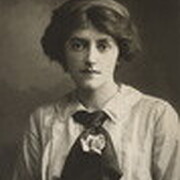F. Tennyson Jesse (1888–1958)
Auteur de A Pin to See the Peepshow
A propos de l'auteur
Notice de désambiguation :
(eng) The author's full name was Fryniwyd Tennyson Jesse (1888-1958). She also wrote under the name Wynifred Margaret Tennyson.
Note that she was, however, christened Wynifried [sic] Margaret Tennyson Jesse; the name 'Fryniwyd' was coined as a playful usage during her teens and adopted by the author for the rest of her life.
Œuvres de F. Tennyson Jesse
The Sword of Deborah: First Hand Impressions of the British Women's Army in France (1919) 7 exemplaires
Tom Fool: A Romance 3 exemplaires
The Trial of Thomas John Ley and Lawrence John Smith 3 exemplaires
Comments on Cain 3 exemplaires
The Railway Carriage [short story] 1 exemplaire
De Quérangals 1 exemplaire
Sabi Pas, or I Don't Know 1 exemplaire
Oeuvres associées
101 Years' Entertainment: The Great Detective Stories 1841-1941 (1941) — Contributeur — 103 exemplaires
The Baffle Book: Fifteen Fiendishly Challenging Detective Puzzles (1928) — Directeur de publication, quelques éditions — 54 exemplaires
The Edge of the Chair: A Superlative Collection, Some Fact, Some Fiction, All Suspense (1967) — Contributeur — 42 exemplaires
Alfred Hitchcock Presents A Baker's Dozen of Suspense Stories (1963) — Contributeur — 35 exemplaires
Nieuwe verhalen die Hitchcock koos — Contributeur — 6 exemplaires
Étiqueté
Partage des connaissances
- Nom légal
- Jesse, Fryniwyd Tennyson
- Autres noms
- Tennyson, Wynifried Margaret
Tinker, Beamish - Date de naissance
- 1888-03-01
- Date de décès
- 1958-08-06
- Sexe
- female
- Nationalité
- UK
- Lieu de naissance
- Chislehurst, Kent, England, UK
- Lieu du décès
- London, England
- Lieux de résidence
- Chislehurst, Kent, England, UK
Guernsey, Bailiwick of Guernsey
Newlyn, Cornwall, UK
St John's Wood, London, England, UK
Surrey, England, UK - Professions
- novelist
journalist
war correspondent
dramatist
criminologist - Relations
- Harwood, Harold Marsh (husband)
Tennyson, Alfred, Lord (great uncle) - Courte biographie
- Grandniece of Alfred, Lord Tennyson
- Notice de désambigüisation
- The author's full name was Fryniwyd Tennyson Jesse (1888-1958). She also wrote under the name Wynifred Margaret Tennyson.
Note that she was, however, christened Wynifried [sic] Margaret Tennyson Jesse; the name 'Fryniwyd' was coined as a playful usage during her teens and adopted by the author for the rest of her life.
Membres
Critiques
Listes
Prix et récompenses
Vous aimerez peut-être aussi
Auteurs associés
Statistiques
- Œuvres
- 27
- Aussi par
- 34
- Membres
- 589
- Popularité
- #42,598
- Évaluation
- 3.7
- Critiques
- 14
- ISBN
- 40
- Langues
- 2
- Favoris
- 1

















But when King Mindoon breathes his last, one of his wives manipulates events to get her daughter - and the easily led Prince she has married- on the throne. In a series of huge massacres, all the rival royals are despatched...
Knowing nothing of Burmese history when I began, this was quite fascinating. As the French, Italians and Brits squabbled over the country, desperate messages to the British government from an imperilled diplomatic staff are largely ignored, as problems in other colonies take precedence.
The author really brings 19th century Mandalay to life. The characters- shallow, exuberant Fanny and the vaguely disatisfied High Church Agatha- are so vividly drawn. Excellent read.… (plus d'informations)